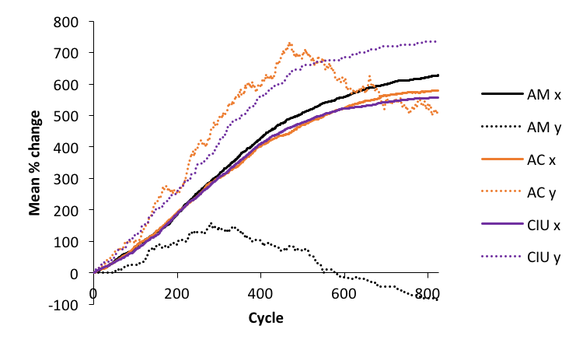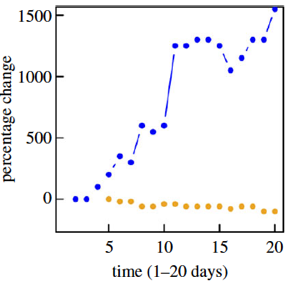Becoming undecided is key to achieving consensus
The spread of foraging innovations through a flock of wild songbirds is best explained by a learning rule where individuals exposed to conflicting information become uncertain. We developed computer simulations and mathematical models to better understand the results of recent experiments on diffusion of foraging innovations in flocks of songbirds.
The new research compares three different rules for learning by imitation. Under the always-copy rule, an individual observing successful behavior copies it, even if they already have a different solution. Under the copy-if-uncertain rule, an individual adopts the observed solution only if they do not already have one. Finally, under the approximate-majority rule, an uncertain individual adopts an observed solution, but becomes undecided about which solution to use if they already have a different solution. Although several phenomena from the bird experiments are accurately simulated by all three rules, only the approximate-majority rule produces the tendency of the population to preferentially adopt the more popular solution (illustrated in the first figure below).
The new research compares three different rules for learning by imitation. Under the always-copy rule, an individual observing successful behavior copies it, even if they already have a different solution. Under the copy-if-uncertain rule, an individual adopts the observed solution only if they do not already have one. Finally, under the approximate-majority rule, an uncertain individual adopts an observed solution, but becomes undecided about which solution to use if they already have a different solution. Although several phenomena from the bird experiments are accurately simulated by all three rules, only the approximate-majority rule produces the tendency of the population to preferentially adopt the more popular solution (illustrated in the first figure below).
Percent change in the number of simulated agents solving a problem with a solution which originated with a small initial majority (x) and an alternate solution (y) discovered later by a single agent. Following diffusion of this knowledge through the population, only the approximate-majority (AM) rule shows a large difference between the majority (solid line) and minority (dotted line) solutions, with the minority solution going extinct. With the other two rules (AC and CIU), the initial minority solution is maintained in about the same proportion as it started. This simulation result provides a strong prediction for bird flocks.
A reanalysis of the bird data from one of the five flocks (Aplin et al., 2015), confirming this prediction of the approximate-majority rule. All five flocks show a similar result.
Achieving consensus is facilitated by eliminating other views in a population. Making an individual undecided about their solution makes it easier to convince that individual to adopt a new solution, particularly one that is more popular. The success of approximate-majority here is remarkable, because it illustrates how complex population-level outcomes like conformity bias and consensus can arise from deceptively simple individual-level learning rules. This is the first application of the approximate-majority rule in social or behavioral science. Its only previous application was to the workings of the cell-cycle switch in molecular biology. Approximate-majority might be useful across a wide range of fields, from the study of epidemics to quorum sensing, social influence, rumors, conversions, spread of memes, emotional contagion, marketing, opinion formation, construction of group norms, and decision-making.
Aplin, L. M., Farine, D. R., Morand-Ferron, J., Cockburn, A., Thornton. A., Sheldon, B. C. (2015). Experimentally induced innovations lead to persistent culture via conformity in wild birds. Nature, 518, 538–541.
Shultz, T. R., Montrey, M., & Aplin, L. M. (2017). Modelling the spread of innovation in wild birds. Journal of the Royal Society Interface, 14: 20170215. http://dx.doi.org/10.1098/rsif.2017.0215
Achieving consensus is facilitated by eliminating other views in a population. Making an individual undecided about their solution makes it easier to convince that individual to adopt a new solution, particularly one that is more popular. The success of approximate-majority here is remarkable, because it illustrates how complex population-level outcomes like conformity bias and consensus can arise from deceptively simple individual-level learning rules. This is the first application of the approximate-majority rule in social or behavioral science. Its only previous application was to the workings of the cell-cycle switch in molecular biology. Approximate-majority might be useful across a wide range of fields, from the study of epidemics to quorum sensing, social influence, rumors, conversions, spread of memes, emotional contagion, marketing, opinion formation, construction of group norms, and decision-making.
Aplin, L. M., Farine, D. R., Morand-Ferron, J., Cockburn, A., Thornton. A., Sheldon, B. C. (2015). Experimentally induced innovations lead to persistent culture via conformity in wild birds. Nature, 518, 538–541.
Shultz, T. R., Montrey, M., & Aplin, L. M. (2017). Modelling the spread of innovation in wild birds. Journal of the Royal Society Interface, 14: 20170215. http://dx.doi.org/10.1098/rsif.2017.0215


